
fuse-med-ml
A python framework accelerating ML based discovery in the medical field by encouraging code reuse. Batteries included :)
Stars: 138
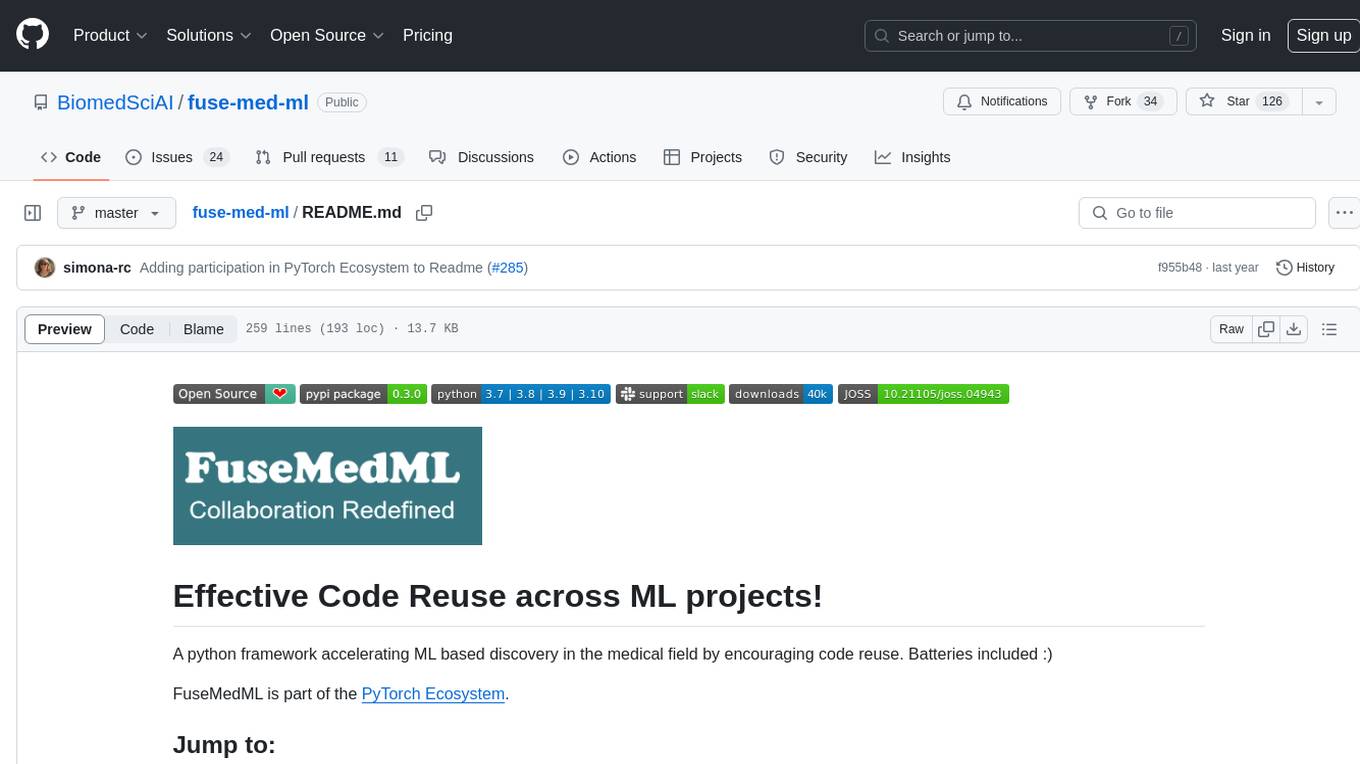
FuseMedML is a Python framework designed to accelerate machine learning-based discovery in the medical field by promoting code reuse. It provides a flexible design concept where data is stored in a nested dictionary, allowing easy handling of multi-modality information. The framework includes components for creating custom models, loss functions, metrics, and data processing operators. Additionally, FuseMedML offers 'batteries included' key components such as fuse.data for data processing, fuse.eval for model evaluation, and fuse.dl for reusable deep learning components. It supports PyTorch and PyTorch Lightning libraries and encourages the creation of domain extensions for specific medical domains.
README:
A python framework accelerating ML based discovery in the medical field by encouraging code reuse. Batteries included :)
FuseMedML is part of the PyTorch Ecosystem.
- install instructions section
- complete code examples
- community support
- Contributing to FuseMedML guide
- citation info
Analyzing many ML research projects we discovered that
- Projects bring up is taking far too long, even when very similar projects were already done in the past by the same lab!
- Porting individual components across projects was painful - resulting in "reinventing the wheel" time after time
This is a key aspect in FuseMedML (shortly named as "fuse"). It's a key driver of flexibility, and allows to easily deal with multi modality information.
from fuse.utils import NDict
sample_ndict = NDict()
sample_ndict['input.mri'] = # ...
sample_ndict['input.ct_view_a'] = # ...
sample_ndict['input.ct_view_b'] = # ...
sample_ndict['groundtruth.disease_level_label'] = # ...This data can be a single sample, it can be for a minibatch, for an entire epoch, or anything that is desired. The "nested key" ("a.b.c.d.etc') is called "path key", as it can be seen as a path inside the nested dictionary.
Components are written in a way that allows to define input and output keys, to be read and written from the nested dict See a short introduction video (3 minutes) to how FuseMedML components work:
https://user-images.githubusercontent.com/7043815/177197158-d3ea0736-629e-4dcb-bd5e-666993fbcfa2.mp4
A multi head model FuseMedML style component, allows easy reuse across projects:
ModelMultiHead(
conv_inputs=(('data.input.img', 1),), # input to the backbone model
backbone=BackboneResnet3D(in_channels=1), # PyTorch nn Module
heads=[ # list of heads - gives the option to support multi task / multi head approach
Head3D(head_name='classification',
mode="classification",
conv_inputs=[("model.backbone_features", 512)] # Input to the classification head
,),
]
)Our default loss implementation - creates an easy wrap around a callable function, while being FuseMedML style
LossDefault(
pred='model.logits.classification', # input - model prediction scores
target='data.label', # input - ground truth labels
callable=torch.nn.functional.cross_entropy # callable - function that will get the prediction scores and labels extracted from batch_dict and compute the loss
)An example metric that can be used
MetricAUCROC(
pred='model.output', # input - model prediction scores
target='data.label' # input - ground truth labels
)Note that several components return answers directly and not write it into the nested dictionary. This is perfectly fine, and to allow maximum flexibility we do not require any usage of output path keys.
Creating custom FuseMedML components is easy - in the following example we add a new data processing operator:
A data pipeline operator
class OpPad(OpBase):
def __call__(self, sample_dict: NDict,
key_in: str,
padding: List[int], fill: int = 0, mode: str = 'constant',
key_out:Optional[str]=None,
):
# we extract the element in the defined key location (for example 'input.xray_img')
img = sample_dict[key_in]
assert isinstance(img, np.ndarray), f'Expected np.ndarray but got {type(img)}'
processed_img = np.pad(img, pad_width=padding, mode=mode, constant_values=fill)
# store the result in the requested output key (or in key_in if no key_out is provided)
key_out = key_in if key_out is None
sample_dict[key_out] = processed_img
# returned the modified nested dict
return sample_dictSince the key location isn't hardcoded, this module can be easily reused across different research projects with very different data sample structures. More code reuse - Hooray!
FuseMedML-style components in general are any classes or functions that define which key paths will be written and which will be read. Arguments can be freely named, and you don't even have to write anything to the nested dict. Some FuseMedML components return a value directly - for example, loss functions.
fuse.data - A declarative super flexible data processing pipeline
- Easy dealing with complex multi modality scenario
- Advanced caching, including periodic audits to automatically detect stale caches
- Default ready-to-use Dataset and Sampler classes
- See detailed introduction here
fuse.eval - a standalone library for evaluating ML models (not necessarily trained with FuseMedML)
The package includes collection of off-the-shelf metrics and utilities such as statistical significance tests, calibration, thresholding, model comparison and more. See detailed introduction here
fuse.dl - reusable dl (deep learning) model architecture components, loss functions, etc.
Some components depend on pytorch. For example, fuse.data is oriented towards pytorch DataSet, DataLoader, DataSampler etc.
fuse.dl makes heavy usage of pytorch models.
Some components do not depend on any specific DL library - for example fuse.eval.
Broadly speaking, the supported DL libraries are:
- "Pure" pytorch
- pytorch-lightning
Before you ask - pytorch-lightning and FuseMedML play along very nicely and have in practice orthogonal and additive benefits :) See Simple FuseMedML + PytorchLightning Example for simple supervised learning cases, and this example for completely custom usage of pytorch-lightning and FuseMedML - useful for advanced scenarios such as Reinforcement Learning and generative models.
fuse-med-ml, the core library, is completely domain agnostic! Domain extensions are optionally installable packages that deal with specific (sub) domains. For example:
- fuseimg which was battle-tested in many medical imaging related projects (different organs, imaging modalities, tasks, etc.)
- fusedrug (to be released soon) which focuses on molecular biology and chemistry - prediction, generation and more
Domain extensions contain concrete implementation of components and components parts within the relevant domain, for example:
- Data pipeline operations - for example, a 3d affine transformation of a 3d image
- Evaluation metrics - for example, a custom metric evaluating docking of a potential drug with a protein target
- Loss functions - for example, a custom segmentation evaluation loss
The recommended directory structure mimics fuse-med-ml core structure
your_package
data #everything related to datasets, samplers, data processing pipeline Ops, etc.
dl #everything related to deep learning architectures, optimizers, loss functions etc.
eval #evaluation metrics
utils #any utilities
You are highly encouraged to create additional domain extensions and/or contribute to the existing ones! There's no need to wait for any approval, you can create domain extensions on your own repos right away
Note - in general, we find it helpful to follow the same directory structure shown above even in small and specific research projects that use FuseMedML for consistency and easy landing for newcomers into your project :)
FuseMedML is tested on Python >= 3.9 and PyTorch >= 2.0
Create a conda environment using the following command (you can replace FUSEMEDML with your preferred enviornment name)
conda create -n FUSEMEDML python=3.9
conda activate FUSEMEDMLNow one shall install PyTorch and it's corresponding cudatoolkit. See here for the exact command that will suit your local environment. For example:
conda install pytorch torchvision torchaudio pytorch-cuda=11.6 -c pytorch -c nvidia
and then do Option 1 or Option 2 below inside the activated conda env
The best way to install FuseMedML is to clone the repository and install it in an editable mode using pip:
$ pip install -e .[all]This mode installs all the currently publicly available domain extensions - fuseimg as of now, fusedrug will be added soon.
To install FuseMedML with an included collection of examples install it using:
$ pip install -e .[all,examples]$ pip install fuse-med-ml[all]or with examples:
$ pip install fuse-med-ml[all,examples]- Easy access "Hello World" colab notebook
- Classification
-
MNIST - a simple example, including training, inference and evaluation over MNIST dataset
-
STOIC - severe COVID-19 classifier baseline given a Computed-Tomography (CT), age group and gender. Challenge description
-
KNIGHT Challenge - preoperative prediction of risk class for patients with renal masses identified in clinical Computed Tomography (CT) imaging of the kidneys. Including data pre-processing, baseline implementation and evaluation pipeline for the challenge.
-
Multimodality tutorial - demonstration of two popular simple methods integrating imaging and clinical data (tabular) using FuseMedML
-
Skin Lesion - skin lesion classification , including training, inference and evaluation over the public dataset introduced in ISIC challenge
-
Breast Cancer Lesion Classification - lesions classification of tumor ( benign, malignant) in breast mammography over the public dataset introduced in The Chinese Mammography Database (CMMD)
-
Mortality prediction for ICU patients - Example of EHR transformer applied to the data of Intensive Care Units patients for in-hospital mortality prediction. The dataset is from PhysioNet Computing in Cardiology Challenge (2012)
-
- Pre-training
- Medical Imaging Pre-training and Downstream Task Validation - pre-training a model on 3D MRI medical imaging and then using it for classification and segmentation downstream tasks.
- Walkthrough Template - includes several TODO notes, marking the minimal scope of code required to get your pipeline up and running. The template also includes useful explanations and tips.
- Slack workspace at fusemedml.slack.com for informal communication - click here to join
- Github Discussions
If you use FuseMedML in scientific context, please consider citing our JOSS paper:
@article{Golts2023,
doi = {10.21105/joss.04943},
url = {https://doi.org/10.21105/joss.04943},
year = {2023},
publisher = {The Open Journal},
volume = {8},
number = {81},
pages = {4943},
author = {Alex Golts and Moshe Raboh and Yoel Shoshan and Sagi Polaczek and Simona Rabinovici-Cohen and Efrat Hexter},
title = {FuseMedML: a framework for accelerated discovery in machine learning based biomedicine},
journal = {Journal of Open Source Software}
}For Tasks:
Click tags to check more tools for each tasksFor Jobs:
Alternative AI tools for fuse-med-ml
Similar Open Source Tools

fuse-med-ml
FuseMedML is a Python framework designed to accelerate machine learning-based discovery in the medical field by promoting code reuse. It provides a flexible design concept where data is stored in a nested dictionary, allowing easy handling of multi-modality information. The framework includes components for creating custom models, loss functions, metrics, and data processing operators. Additionally, FuseMedML offers 'batteries included' key components such as fuse.data for data processing, fuse.eval for model evaluation, and fuse.dl for reusable deep learning components. It supports PyTorch and PyTorch Lightning libraries and encourages the creation of domain extensions for specific medical domains.
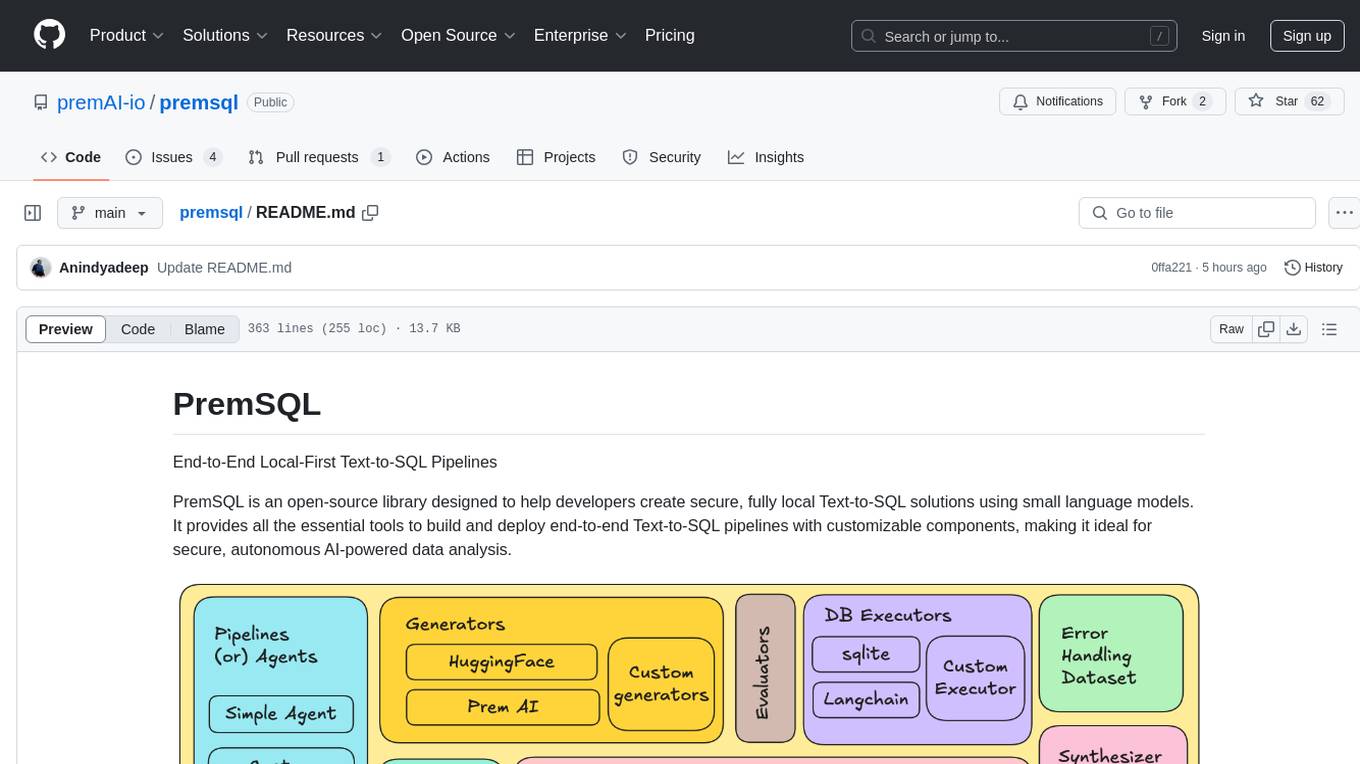
premsql
PremSQL is an open-source library designed to help developers create secure, fully local Text-to-SQL solutions using small language models. It provides essential tools for building and deploying end-to-end Text-to-SQL pipelines with customizable components, ideal for secure, autonomous AI-powered data analysis. The library offers features like Local-First approach, Customizable Datasets, Robust Executors and Evaluators, Advanced Generators, Error Handling and Self-Correction, Fine-Tuning Support, and End-to-End Pipelines. Users can fine-tune models, generate SQL queries from natural language inputs, handle errors, and evaluate model performance against predefined metrics. PremSQL is extendible for customization and private data usage.
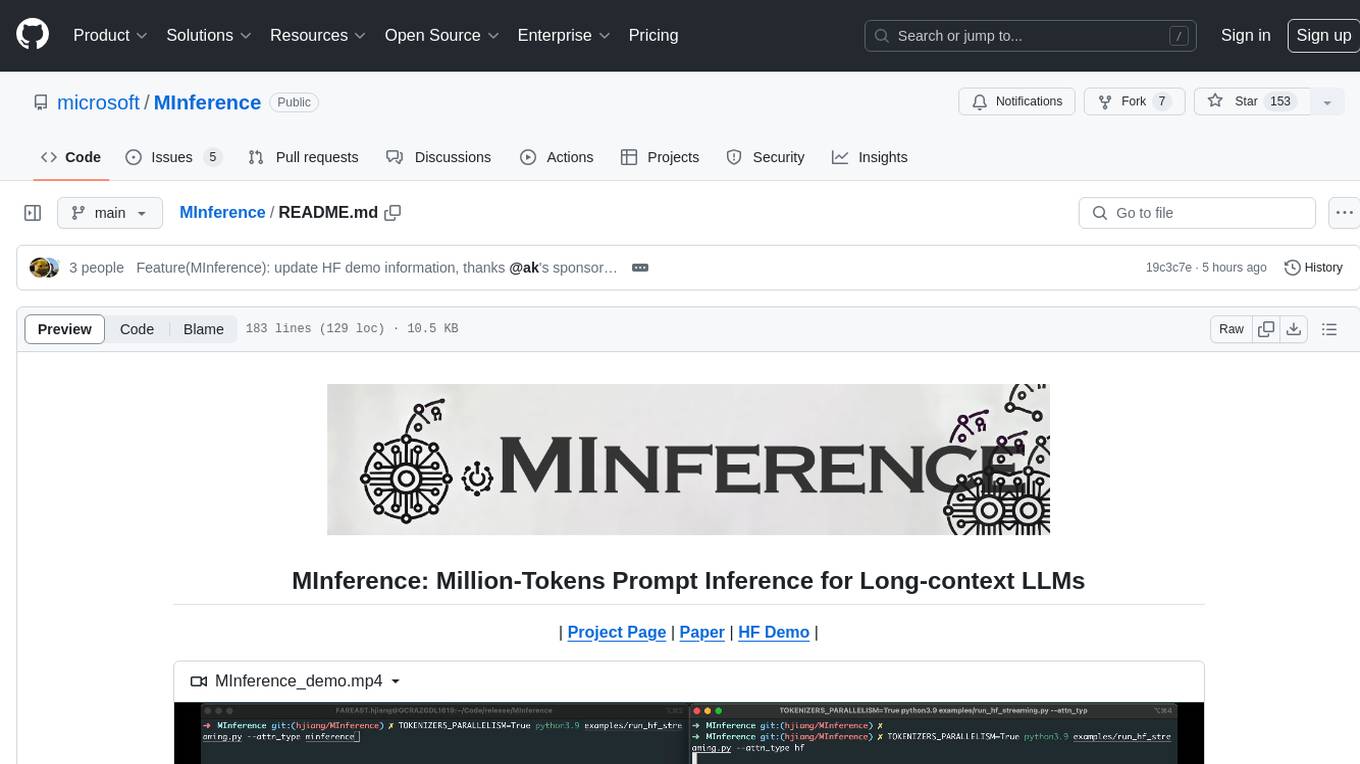
MInference
MInference is a tool designed to accelerate pre-filling for long-context Language Models (LLMs) by leveraging dynamic sparse attention. It achieves up to a 10x speedup for pre-filling on an A100 while maintaining accuracy. The tool supports various decoding LLMs, including LLaMA-style models and Phi models, and provides custom kernels for attention computation. MInference is useful for researchers and developers working with large-scale language models who aim to improve efficiency without compromising accuracy.

instructor-php
Instructor for PHP is a library designed for structured data extraction in PHP, powered by Large Language Models (LLMs). It simplifies the process of extracting structured, validated data from unstructured text or chat sequences. Instructor enhances workflow by providing a response model, validation capabilities, and max retries for requests. It supports classes as response models and provides features like partial results, string input, extracting scalar and enum values, and specifying data models using PHP type hints or DocBlock comments. The library allows customization of validation and provides detailed event notifications during request processing. Instructor is compatible with PHP 8.2+ and leverages PHP reflection, Symfony components, and SaloonPHP for communication with LLM API providers.
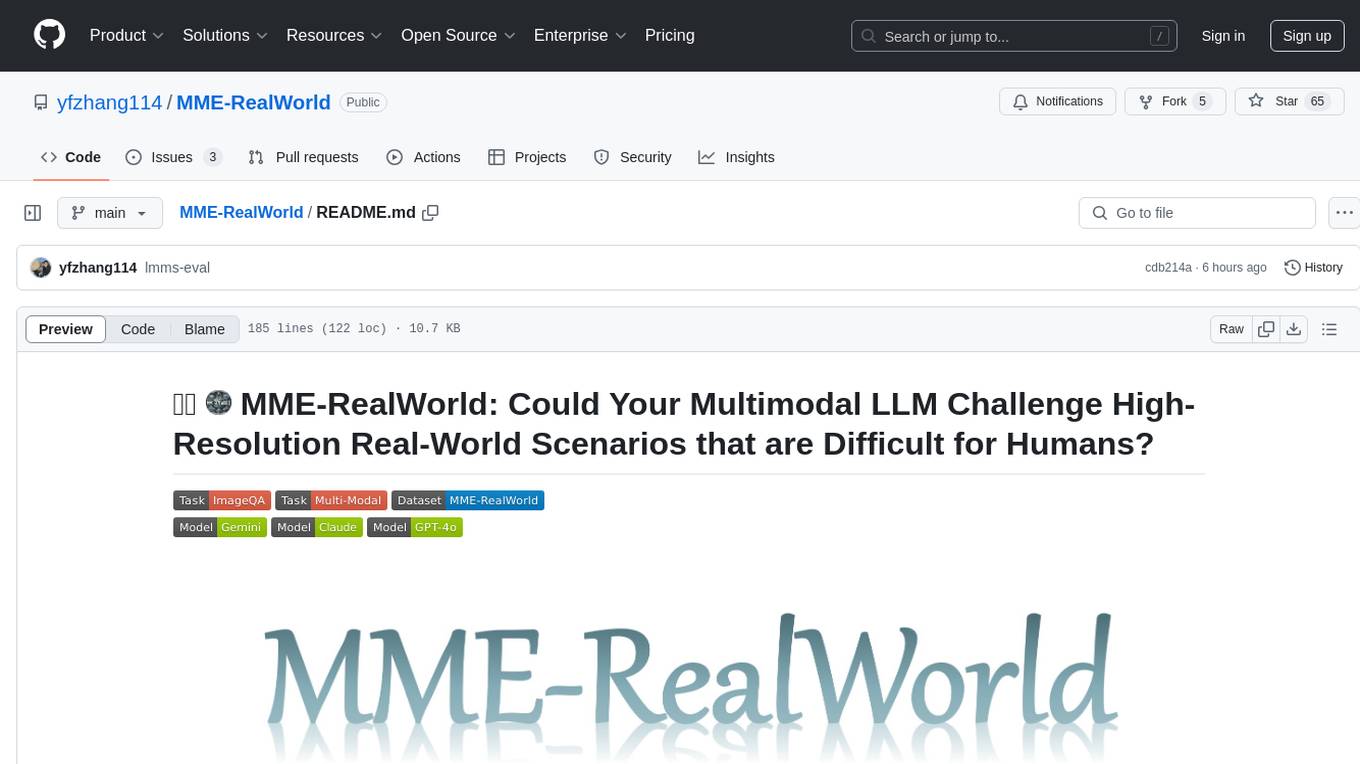
MME-RealWorld
MME-RealWorld is a benchmark designed to address real-world applications with practical relevance, featuring 13,366 high-resolution images and 29,429 annotations across 43 tasks. It aims to provide substantial recognition challenges and overcome common barriers in existing Multimodal Large Language Model benchmarks, such as small data scale, restricted data quality, and insufficient task difficulty. The dataset offers advantages in data scale, data quality, task difficulty, and real-world utility compared to existing benchmarks. It also includes a Chinese version with additional images and QA pairs focused on Chinese scenarios.
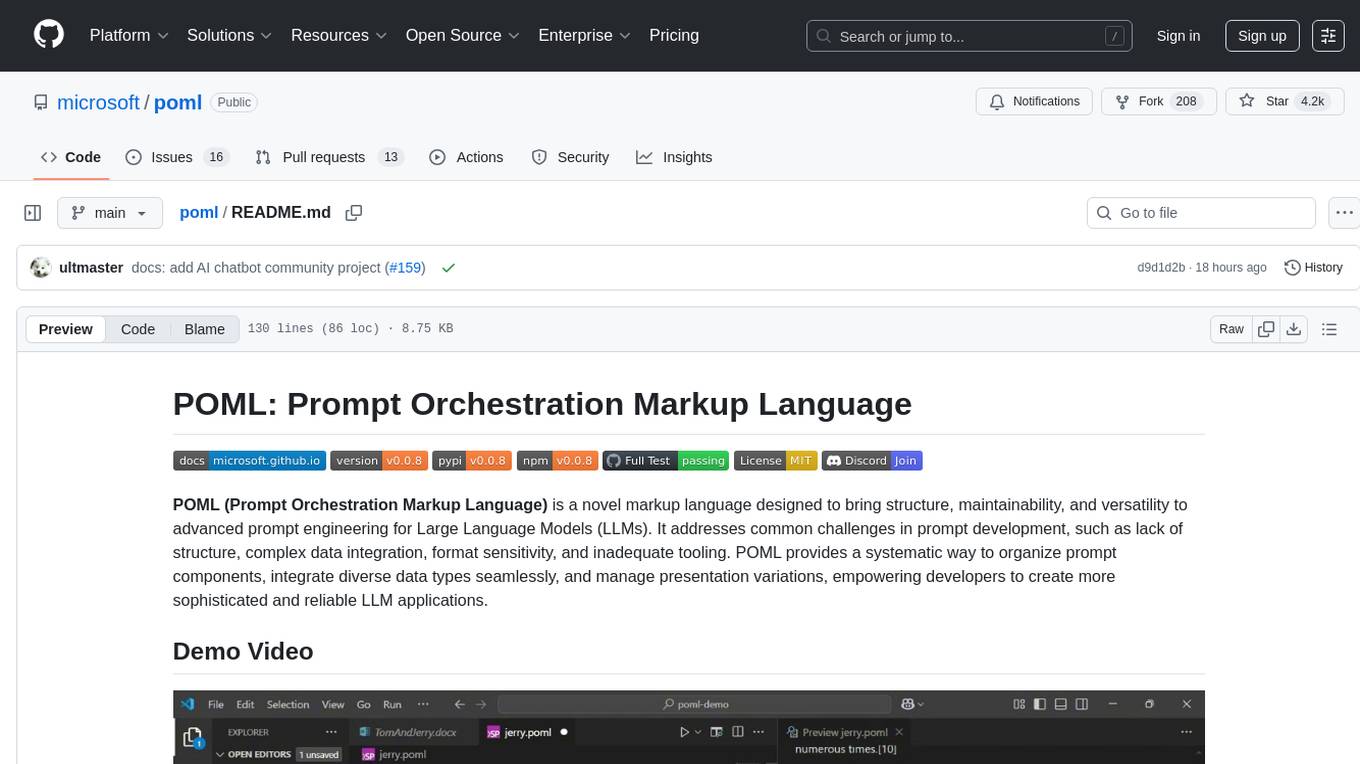
poml
POML (Prompt Orchestration Markup Language) is a novel markup language designed to bring structure, maintainability, and versatility to advanced prompt engineering for Large Language Models (LLMs). It addresses common challenges in prompt development, such as lack of structure, complex data integration, format sensitivity, and inadequate tooling. POML provides a systematic way to organize prompt components, integrate diverse data types seamlessly, and manage presentation variations, empowering developers to create more sophisticated and reliable LLM applications.
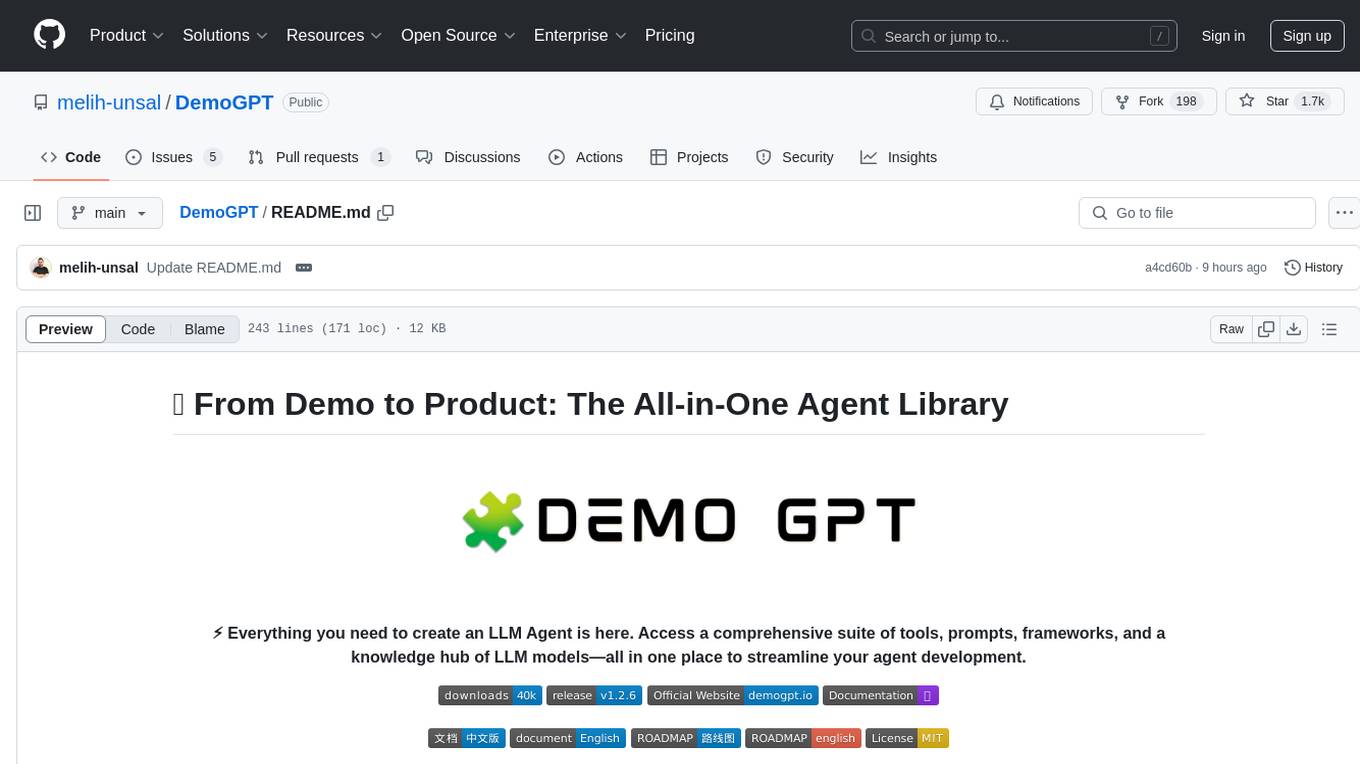
DemoGPT
DemoGPT is an all-in-one agent library that provides tools, prompts, frameworks, and LLM models for streamlined agent development. It leverages GPT-3.5-turbo to generate LangChain code, creating interactive Streamlit applications. The tool is designed for creating intelligent, interactive, and inclusive solutions in LLM-based application development. It offers model flexibility, iterative development, and a commitment to user engagement. Future enhancements include integrating Gorilla for autonomous API usage and adding a publicly available database for refining the generation process.
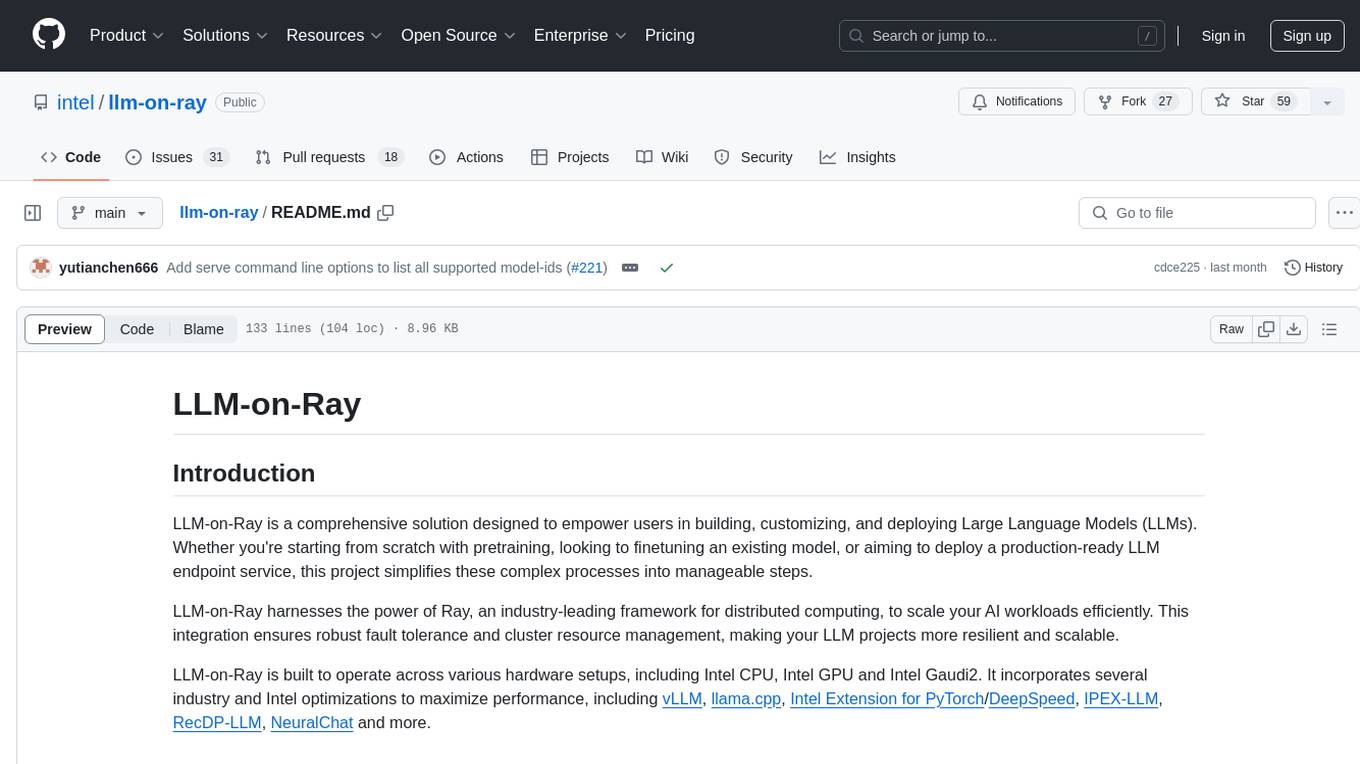
llm-on-ray
LLM-on-Ray is a comprehensive solution for building, customizing, and deploying Large Language Models (LLMs). It simplifies complex processes into manageable steps by leveraging the power of Ray for distributed computing. The tool supports pretraining, finetuning, and serving LLMs across various hardware setups, incorporating industry and Intel optimizations for performance. It offers modular workflows with intuitive configurations, robust fault tolerance, and scalability. Additionally, it provides an Interactive Web UI for enhanced usability, including a chatbot application for testing and refining models.
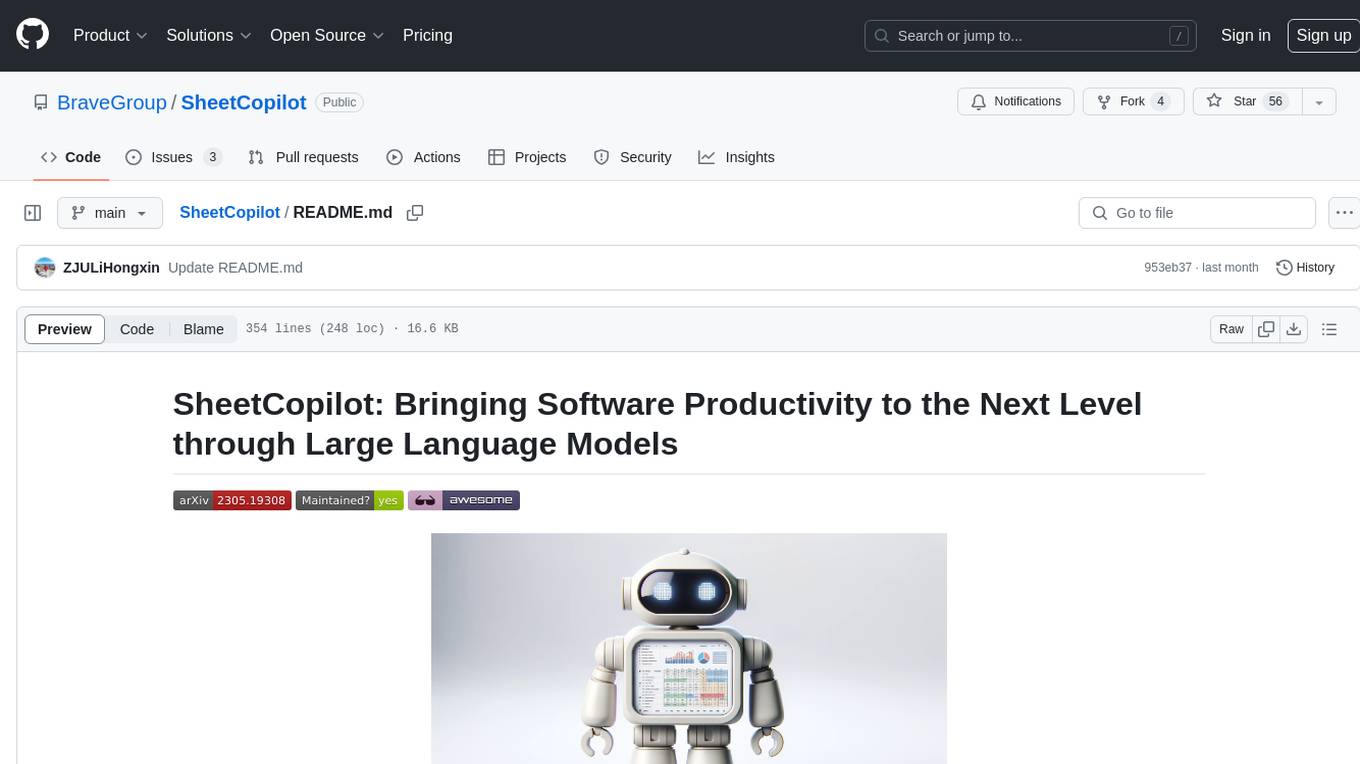
SheetCopilot
SheetCopilot is an assistant agent that manipulates spreadsheets by following user commands. It leverages Large Language Models (LLMs) to interact with spreadsheets like a human expert, enabling non-expert users to complete tasks on complex software such as Google Sheets and Excel via a language interface. The tool observes spreadsheet states, polishes generated solutions based on external action documents and error feedback, and aims to improve success rate and efficiency. SheetCopilot offers a dataset with diverse task categories and operations, supporting operations like entry & manipulation, management, formatting, charts, and pivot tables. Users can interact with SheetCopilot in Excel or Google Sheets, executing tasks like calculating revenue, creating pivot tables, and plotting charts. The tool's evaluation includes performance comparisons with leading LLMs and VBA-based methods on specific datasets, showcasing its capabilities in controlling various aspects of a spreadsheet.
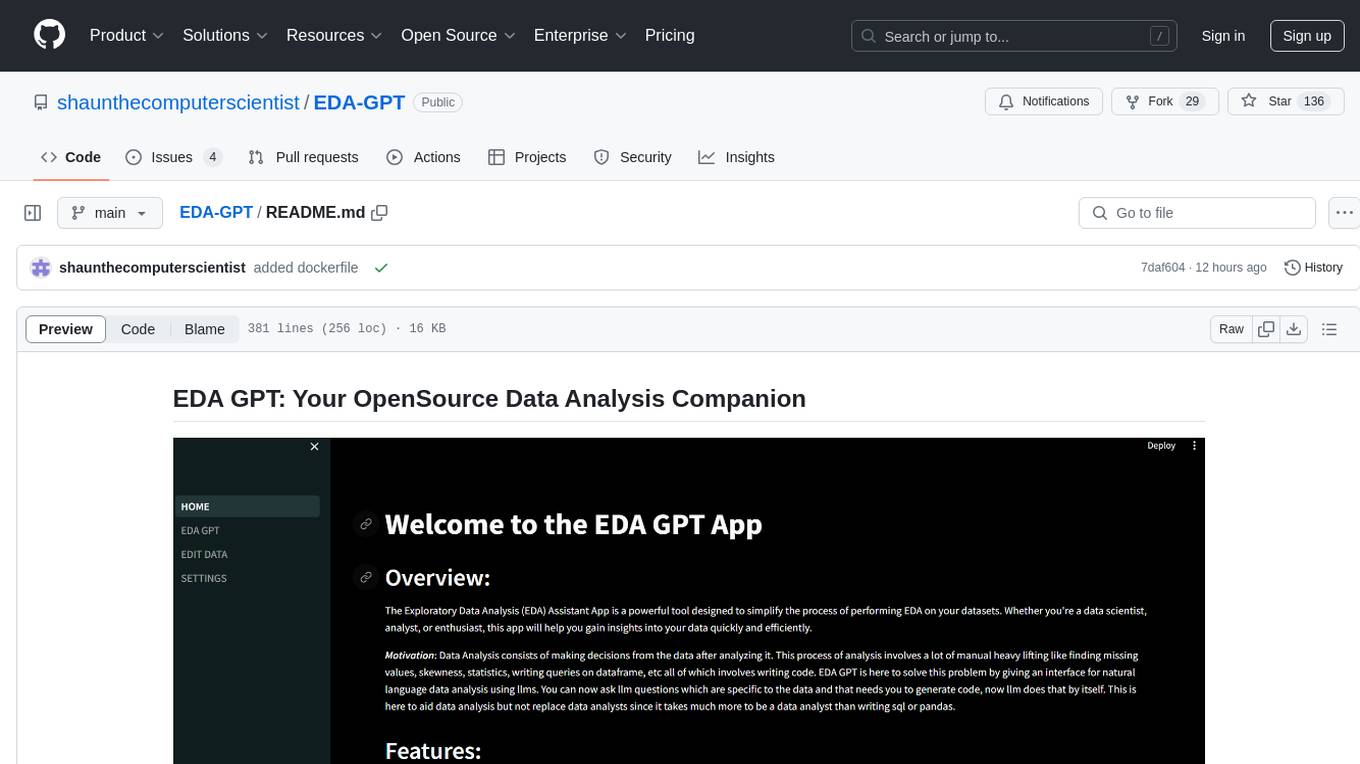
EDA-GPT
EDA GPT is an open-source data analysis companion that offers a comprehensive solution for structured and unstructured data analysis. It streamlines the data analysis process, empowering users to explore, visualize, and gain insights from their data. EDA GPT supports analyzing structured data in various formats like CSV, XLSX, and SQLite, generating graphs, and conducting in-depth analysis of unstructured data such as PDFs and images. It provides a user-friendly interface, powerful features, and capabilities like comparing performance with other tools, analyzing large language models, multimodal search, data cleaning, and editing. The tool is optimized for maximal parallel processing, searching internet and documents, and creating analysis reports from structured and unstructured data.
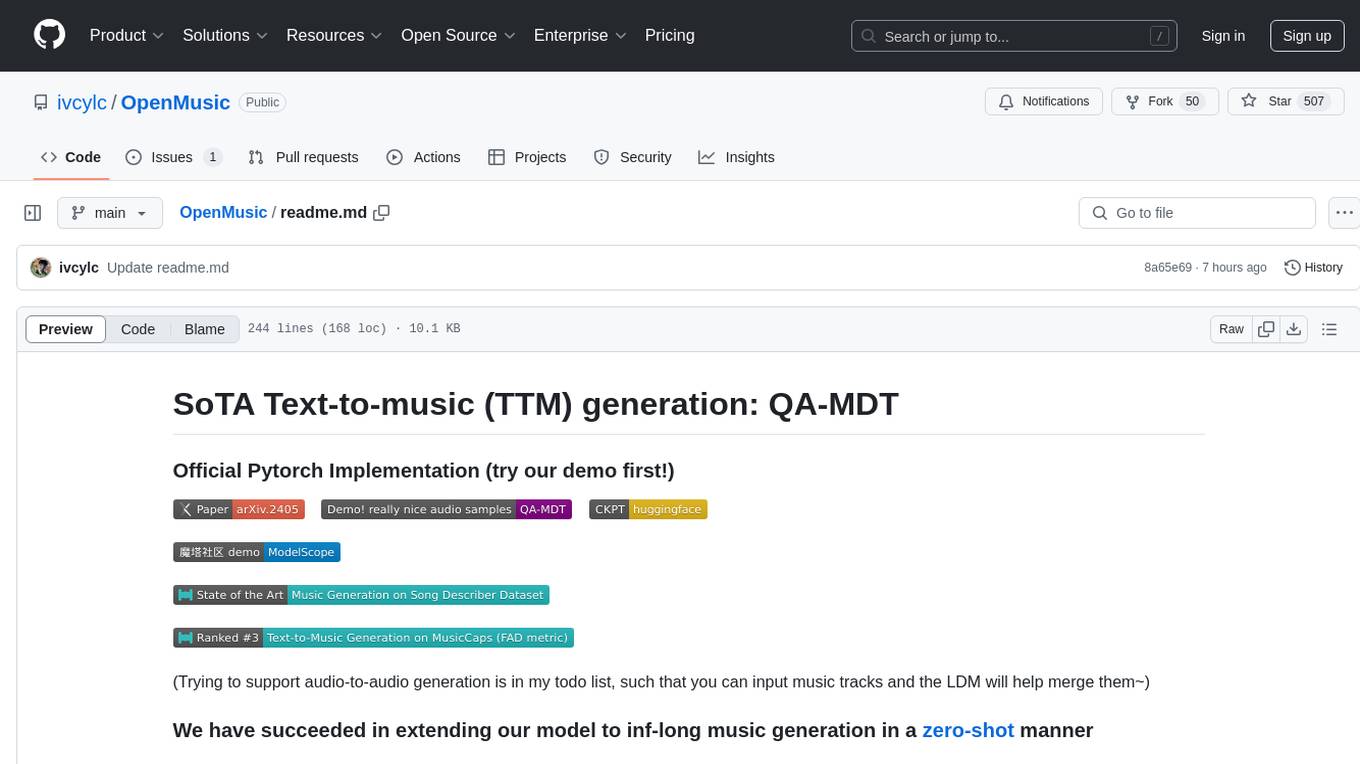
OpenMusic
OpenMusic is a repository providing an implementation of QA-MDT, a Quality-Aware Masked Diffusion Transformer for music generation. The code integrates state-of-the-art models and offers training strategies for music generation. The repository includes implementations of AudioLDM, PixArt-alpha, MDT, AudioMAE, and Open-Sora. Users can train or fine-tune the model using different strategies and datasets. The model is well-pretrained and can be used for music generation tasks. The repository also includes instructions for preparing datasets, training the model, and performing inference. Contact information is provided for any questions or suggestions regarding the project.
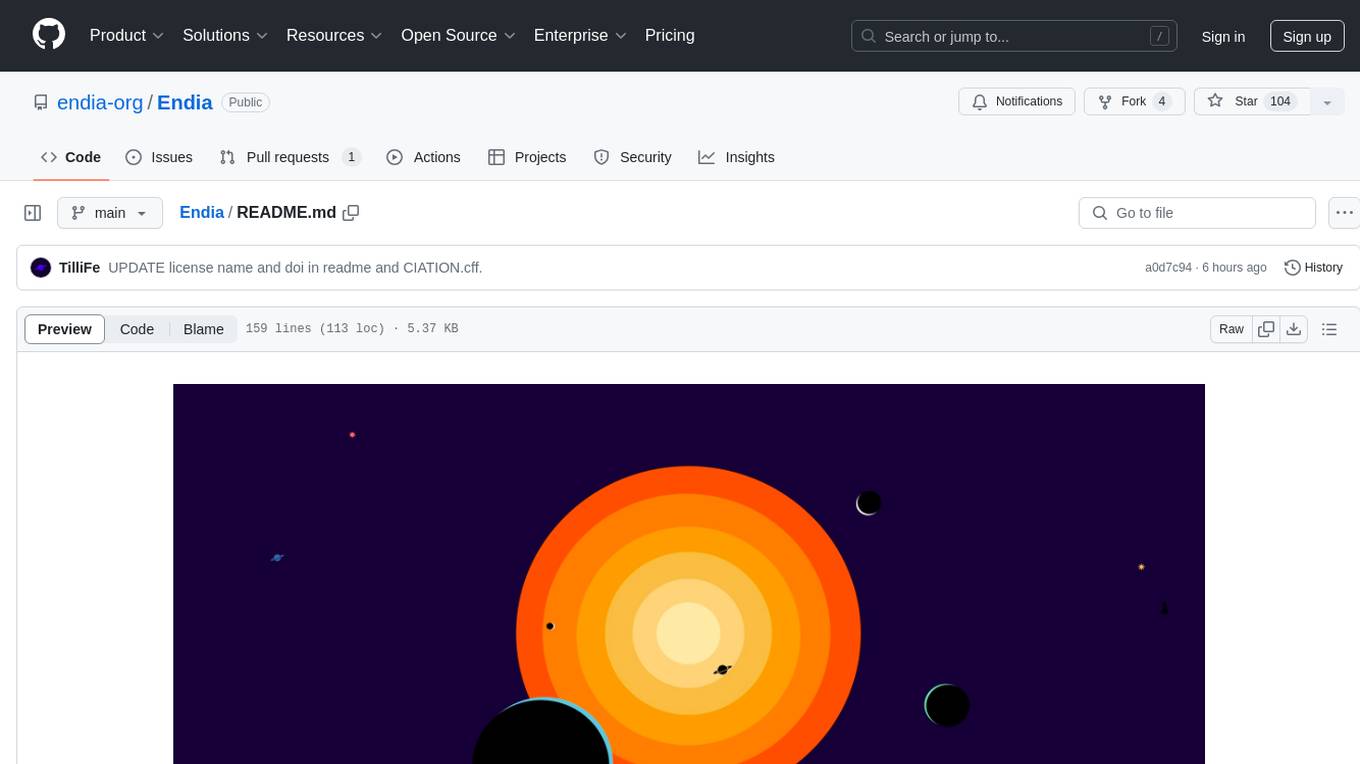
Endia
Endia is a dynamic Array library for Scientific Computing, offering automatic differentiation of arbitrary order, complex number support, dual API with PyTorch-like imperative or JAX-like functional interface, and JIT Compilation for speeding up training and inference. It can handle complex valued functions, perform both forward and reverse-mode automatic differentiation, and has a builtin JIT compiler. Endia aims to advance AI & Scientific Computing by pushing boundaries with clear algorithms, providing high-performance open-source code that remains readable and pythonic, and prioritizing clarity and educational value over exhaustive features.
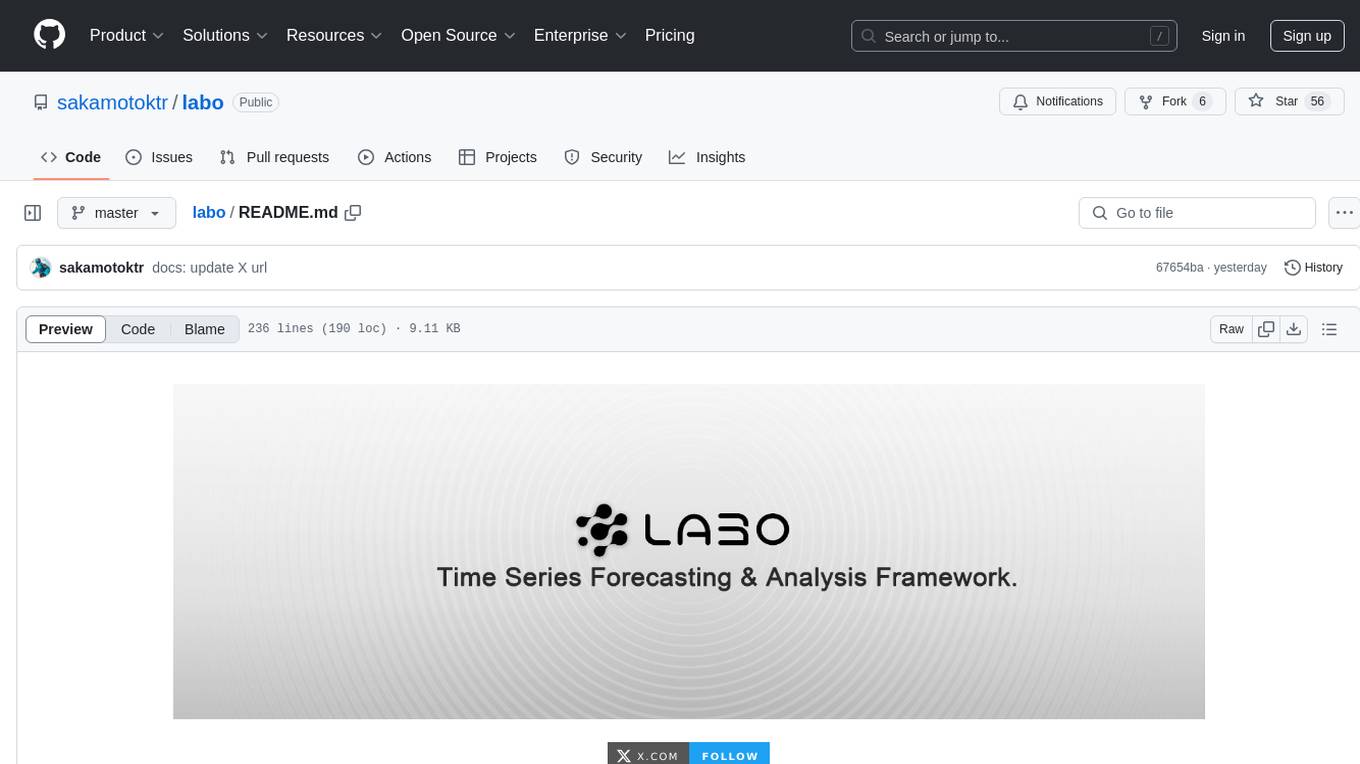
labo
LABO is a time series forecasting and analysis framework that integrates pre-trained and fine-tuned LLMs with multi-domain agent-based systems. It allows users to create and tune agents easily for various scenarios, such as stock market trend prediction and web public opinion analysis. LABO requires a specific runtime environment setup, including system requirements, Python environment, dependency installations, and configurations. Users can fine-tune their own models using LABO's Low-Rank Adaptation (LoRA) for computational efficiency and continuous model updates. Additionally, LABO provides a Python library for building model training pipelines and customizing agents for specific tasks.
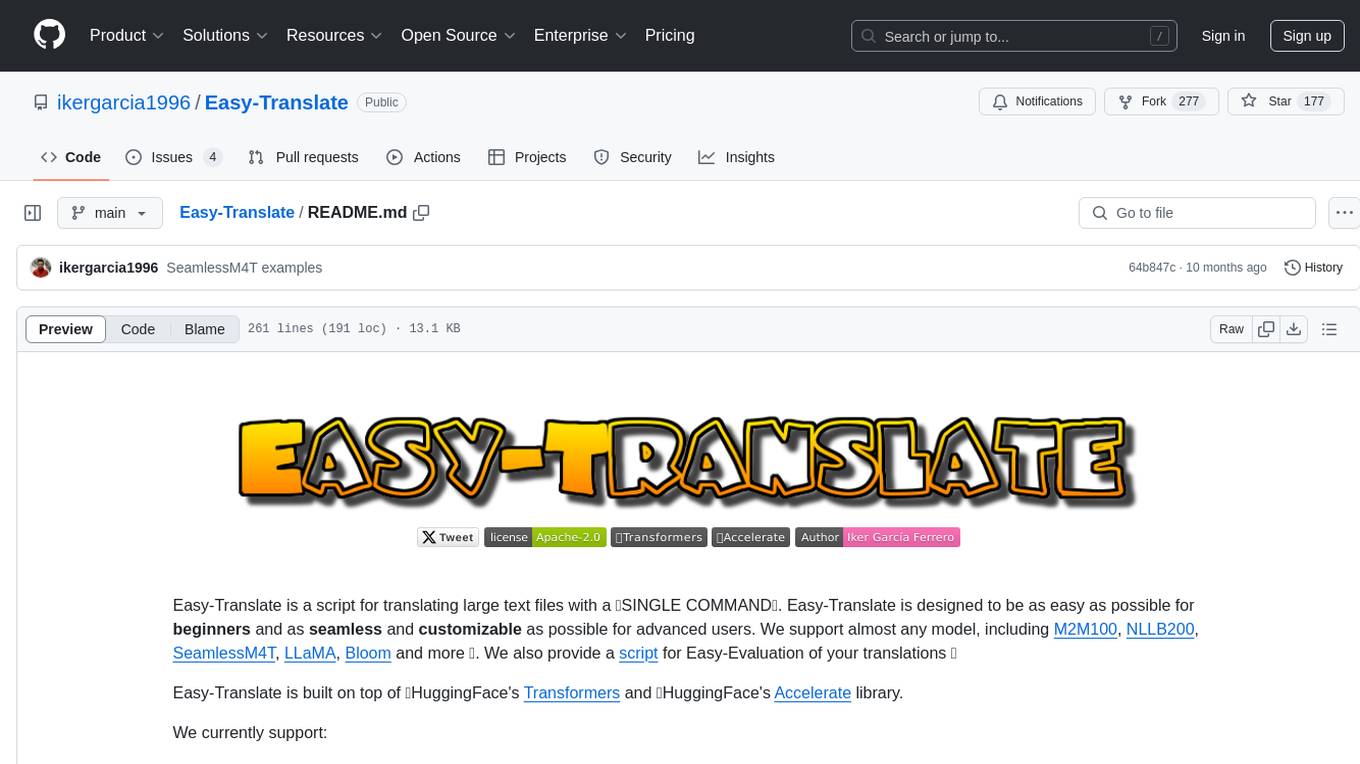
Easy-Translate
Easy-Translate is a script designed for translating large text files with a single command. It supports various models like M2M100, NLLB200, SeamlessM4T, LLaMA, and Bloom. The tool is beginner-friendly and offers seamless and customizable features for advanced users. It allows acceleration on CPU, multi-CPU, GPU, multi-GPU, and TPU, with support for different precisions and decoding strategies. Easy-Translate also provides an evaluation script for translations. Built on HuggingFace's Transformers and Accelerate library, it supports prompt usage and loading huge models efficiently.
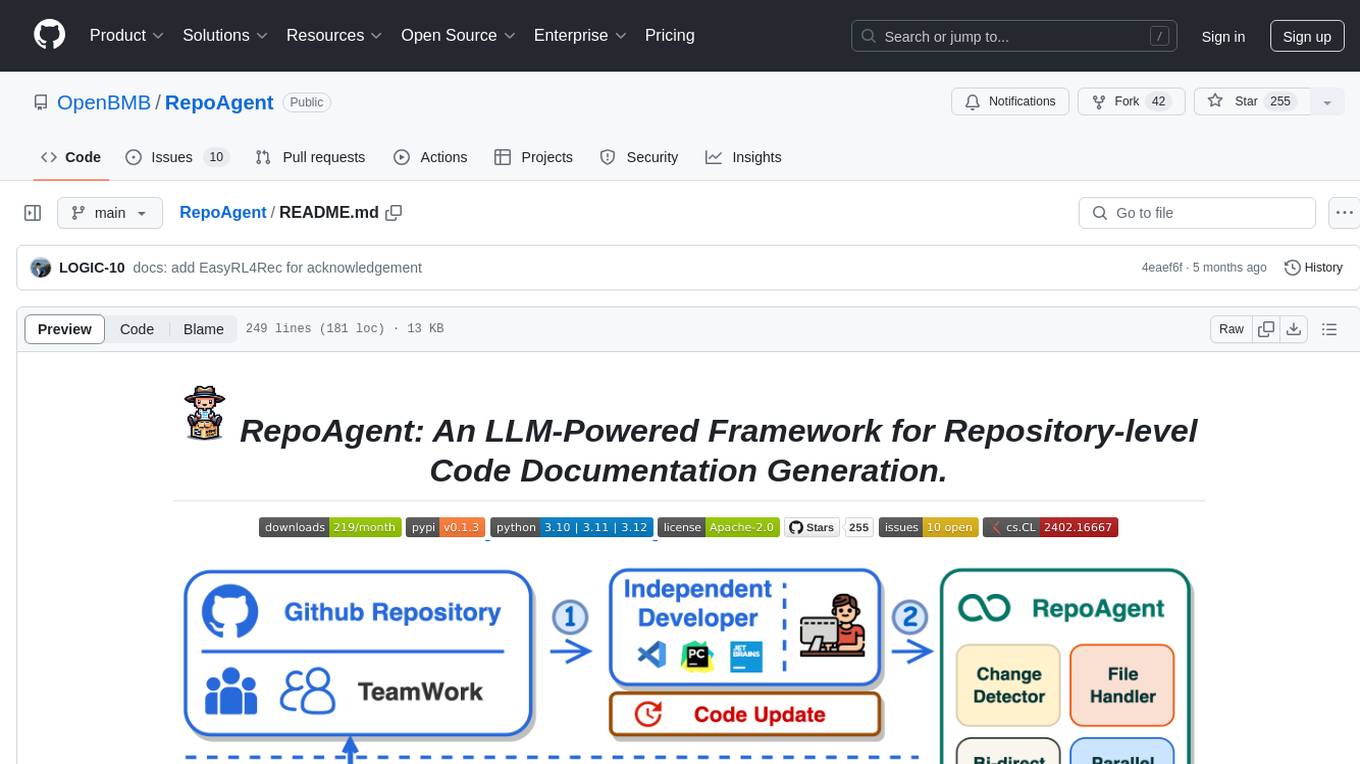
RepoAgent
RepoAgent is an LLM-powered framework designed for repository-level code documentation generation. It automates the process of detecting changes in Git repositories, analyzing code structure through AST, identifying inter-object relationships, replacing Markdown content, and executing multi-threaded operations. The tool aims to assist developers in understanding and maintaining codebases by providing comprehensive documentation, ultimately improving efficiency and saving time.
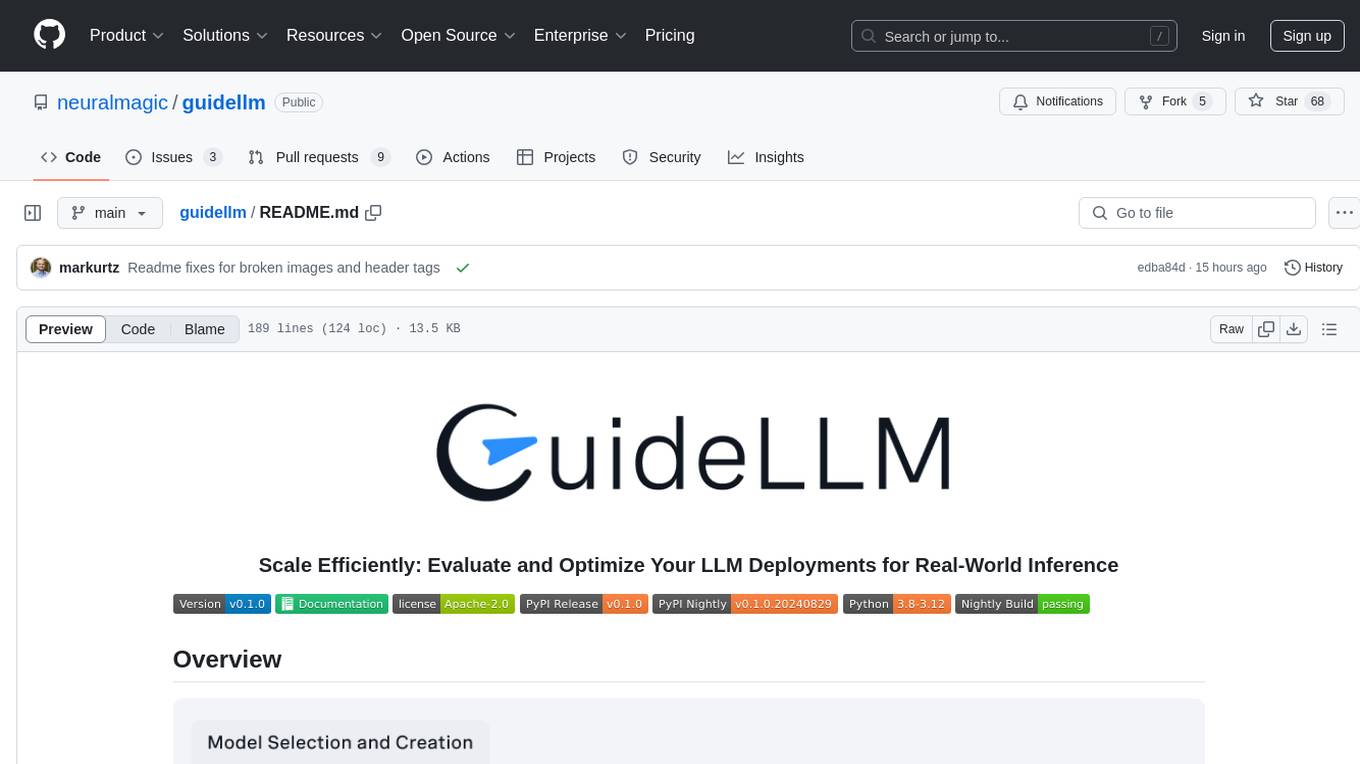
guidellm
GuideLLM is a powerful tool for evaluating and optimizing the deployment of large language models (LLMs). By simulating real-world inference workloads, GuideLLM helps users gauge the performance, resource needs, and cost implications of deploying LLMs on various hardware configurations. This approach ensures efficient, scalable, and cost-effective LLM inference serving while maintaining high service quality. Key features include performance evaluation, resource optimization, cost estimation, and scalability testing.
For similar tasks

fuse-med-ml
FuseMedML is a Python framework designed to accelerate machine learning-based discovery in the medical field by promoting code reuse. It provides a flexible design concept where data is stored in a nested dictionary, allowing easy handling of multi-modality information. The framework includes components for creating custom models, loss functions, metrics, and data processing operators. Additionally, FuseMedML offers 'batteries included' key components such as fuse.data for data processing, fuse.eval for model evaluation, and fuse.dl for reusable deep learning components. It supports PyTorch and PyTorch Lightning libraries and encourages the creation of domain extensions for specific medical domains.
For similar jobs
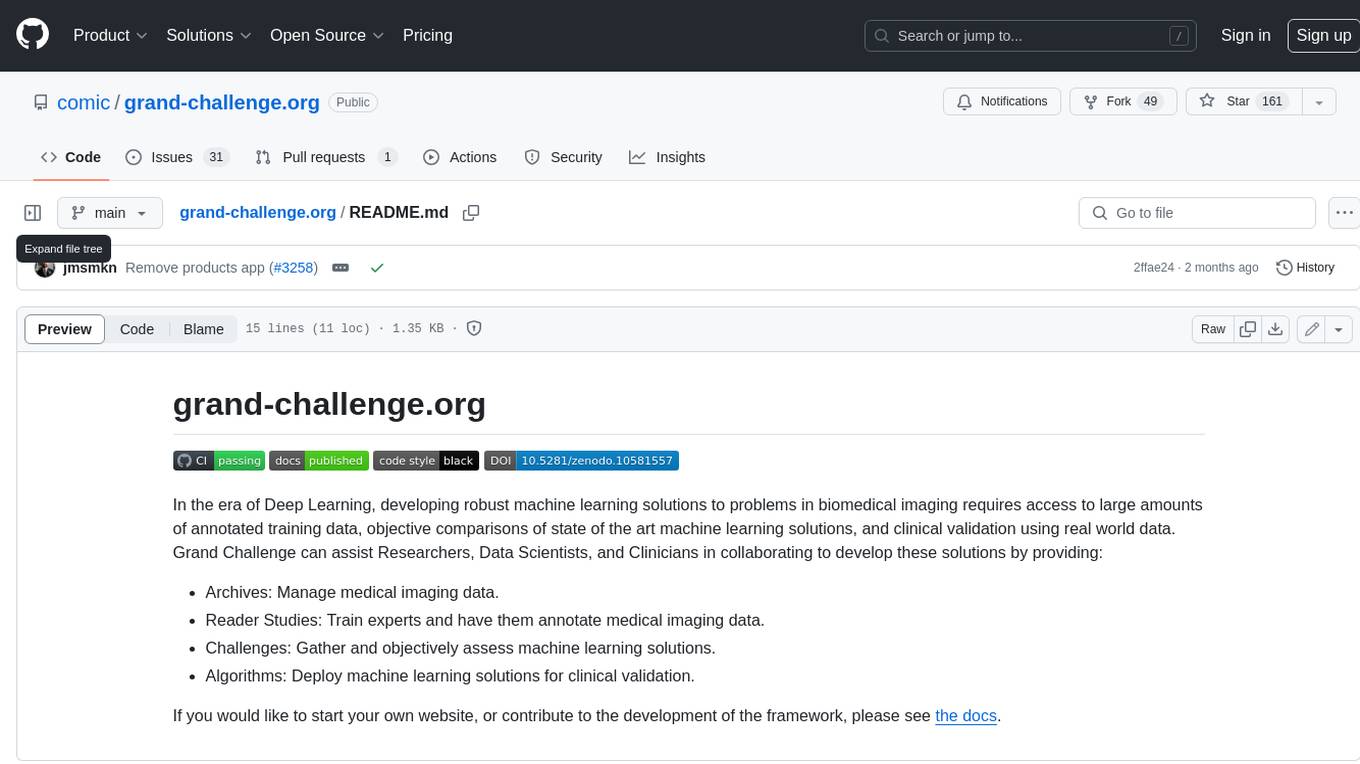
grand-challenge.org
Grand Challenge is a platform that provides access to large amounts of annotated training data, objective comparisons of state-of-the-art machine learning solutions, and clinical validation using real-world data. It assists researchers, data scientists, and clinicians in collaborating to develop robust machine learning solutions to problems in biomedical imaging.
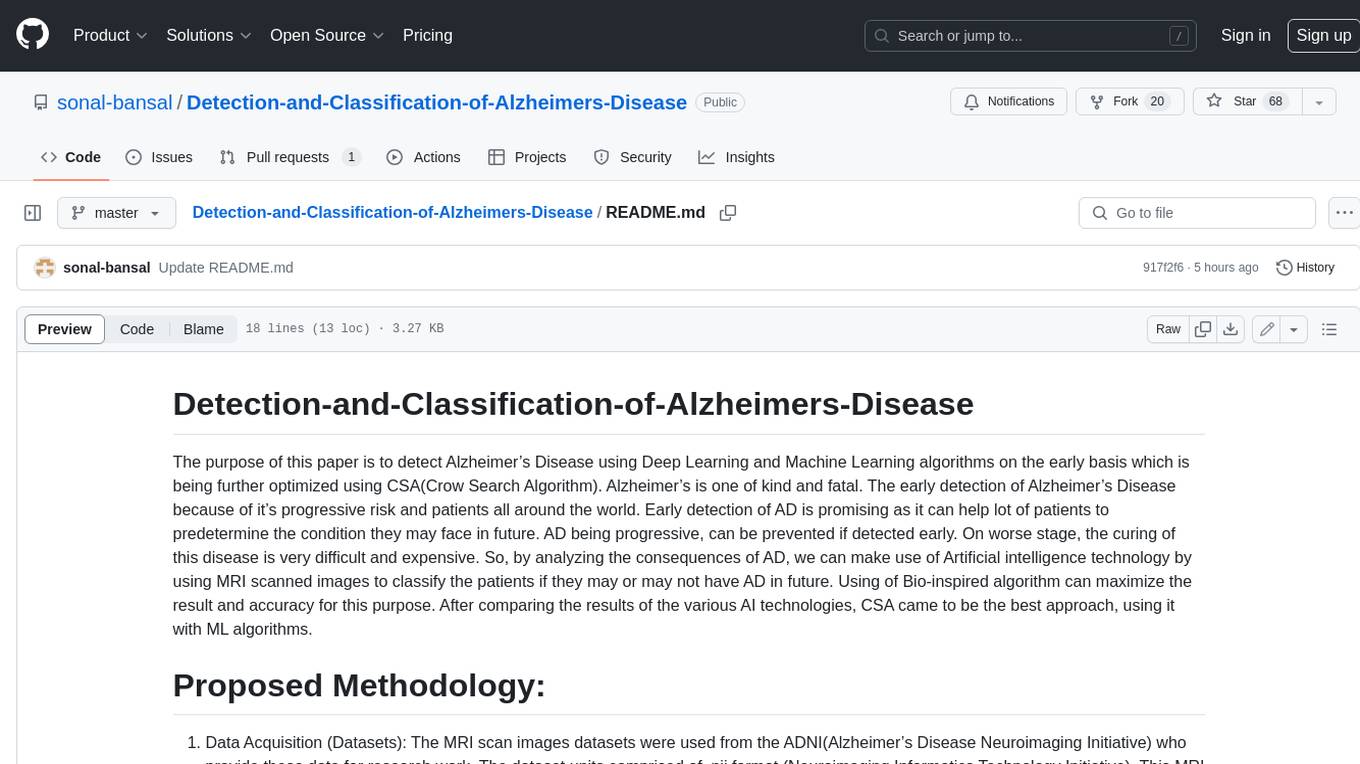
Detection-and-Classification-of-Alzheimers-Disease
This tool is designed to detect and classify Alzheimer's Disease using Deep Learning and Machine Learning algorithms on an early basis, which is further optimized using the Crow Search Algorithm (CSA). Alzheimer's is a fatal disease, and early detection is crucial for patients to predetermine their condition and prevent its progression. By analyzing MRI scanned images using Artificial Intelligence technology, this tool can classify patients who may or may not develop AD in the future. The CSA algorithm, combined with ML algorithms, has proven to be the most effective approach for this purpose.
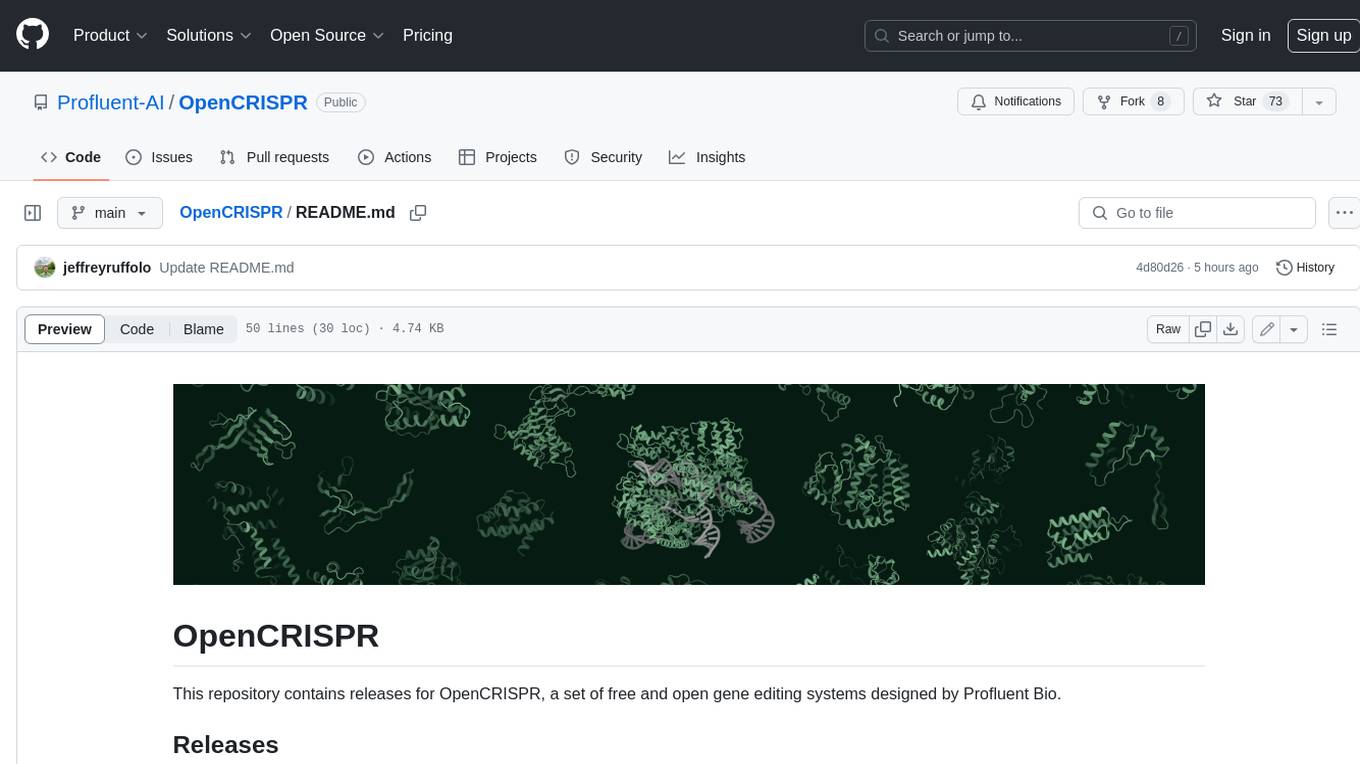
OpenCRISPR
OpenCRISPR is a set of free and open gene editing systems designed by Profluent Bio. The OpenCRISPR-1 protein maintains the prototypical architecture of a Type II Cas9 nuclease but is hundreds of mutations away from SpCas9 or any other known natural CRISPR-associated protein. You can view OpenCRISPR-1 as a drop-in replacement for many protocols that need a cas9-like protein with an NGG PAM and you can even use it with canonical SpCas9 gRNAs. OpenCRISPR-1 can be fused in a deactivated or nickase format for next generation gene editing techniques like base, prime, or epigenome editing.
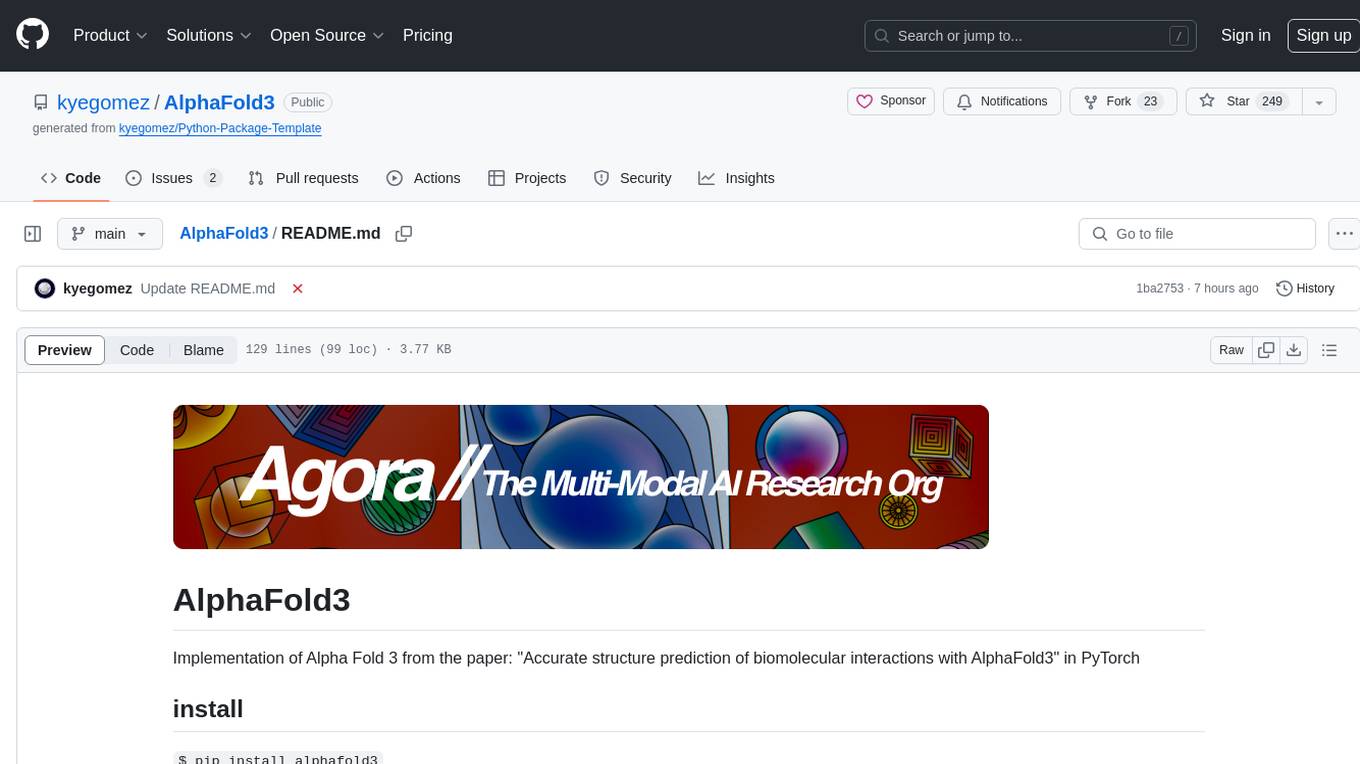
AlphaFold3
AlphaFold3 is an implementation of the Alpha Fold 3 model in PyTorch for accurate structure prediction of biomolecular interactions. It includes modules for genetic diffusion and full model examples for forward pass computations. The tool allows users to generate random pair and single representations, operate on atomic coordinates, and perform structure predictions based on input tensors. The implementation also provides functionalities for training and evaluating the model.

fuse-med-ml
FuseMedML is a Python framework designed to accelerate machine learning-based discovery in the medical field by promoting code reuse. It provides a flexible design concept where data is stored in a nested dictionary, allowing easy handling of multi-modality information. The framework includes components for creating custom models, loss functions, metrics, and data processing operators. Additionally, FuseMedML offers 'batteries included' key components such as fuse.data for data processing, fuse.eval for model evaluation, and fuse.dl for reusable deep learning components. It supports PyTorch and PyTorch Lightning libraries and encourages the creation of domain extensions for specific medical domains.
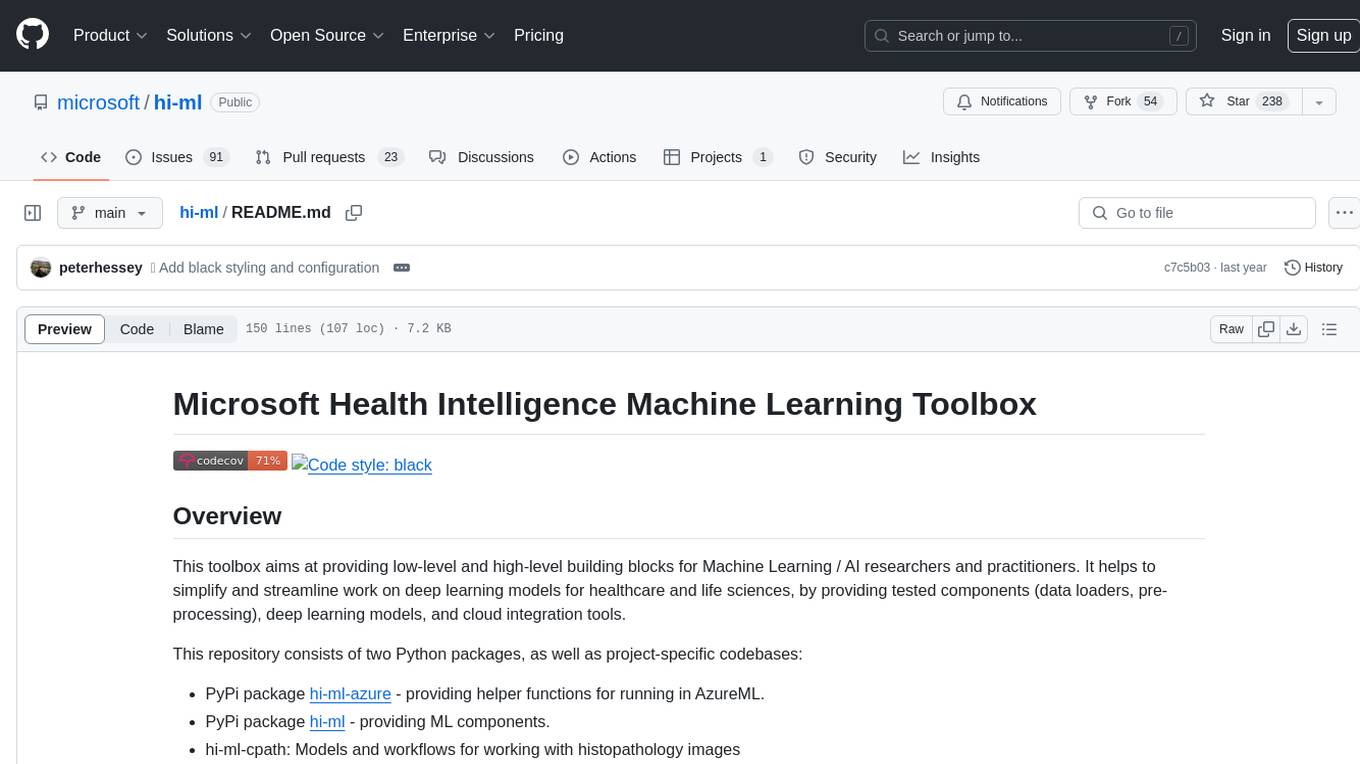
hi-ml
The Microsoft Health Intelligence Machine Learning Toolbox is a repository that provides low-level and high-level building blocks for Machine Learning / AI researchers and practitioners. It simplifies and streamlines work on deep learning models for healthcare and life sciences by offering tested components such as data loaders, pre-processing tools, deep learning models, and cloud integration utilities. The repository includes two Python packages, 'hi-ml-azure' for helper functions in AzureML, 'hi-ml' for ML components, and 'hi-ml-cpath' for models and workflows related to histopathology images.
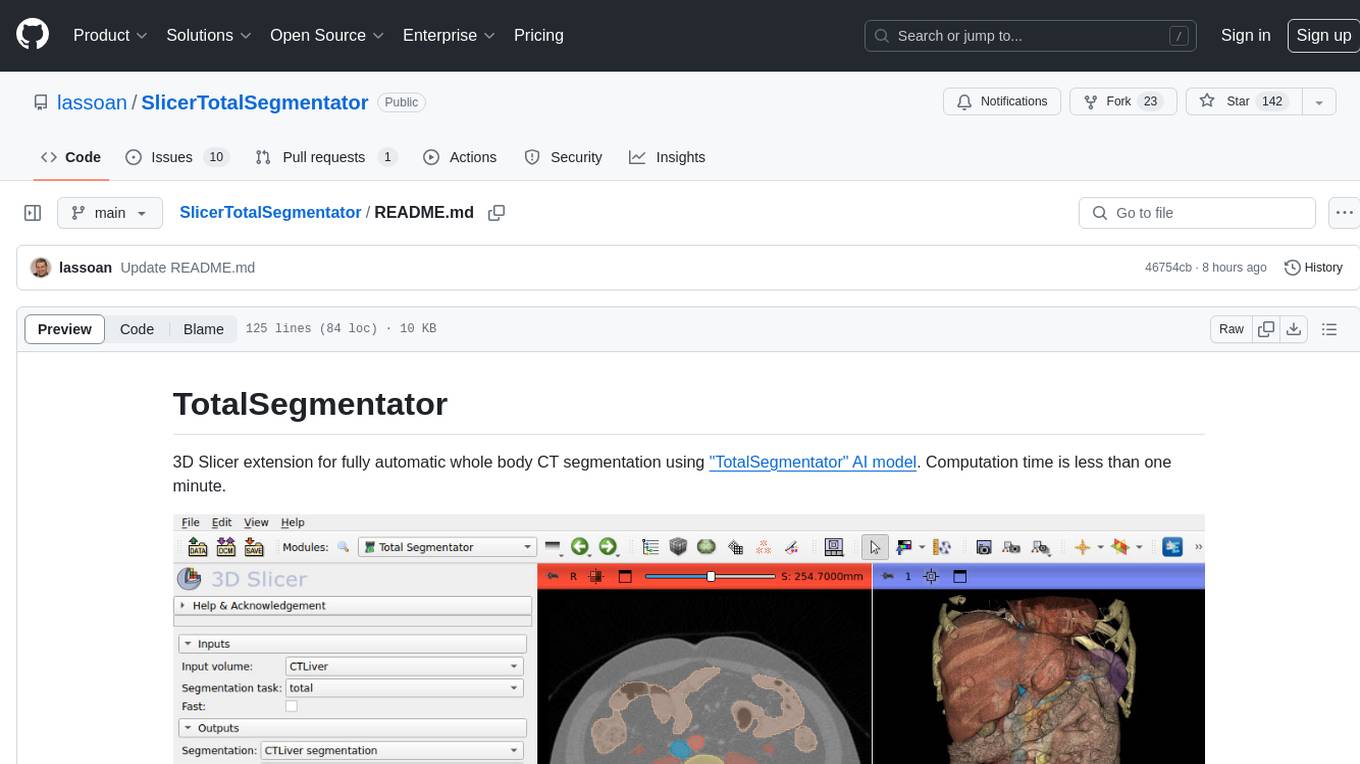
SlicerTotalSegmentator
TotalSegmentator is a 3D Slicer extension designed for fully automatic whole body CT segmentation using the 'TotalSegmentator' AI model. The computation time is less than one minute, making it efficient for research purposes. Users can set up GPU acceleration for faster segmentation. The tool provides a user-friendly interface for loading CT images, creating segmentations, and displaying results in 3D. Troubleshooting steps are available for common issues such as failed computation, GPU errors, and inaccurate segmentations. Contributions to the extension are welcome, following 3D Slicer contribution guidelines.
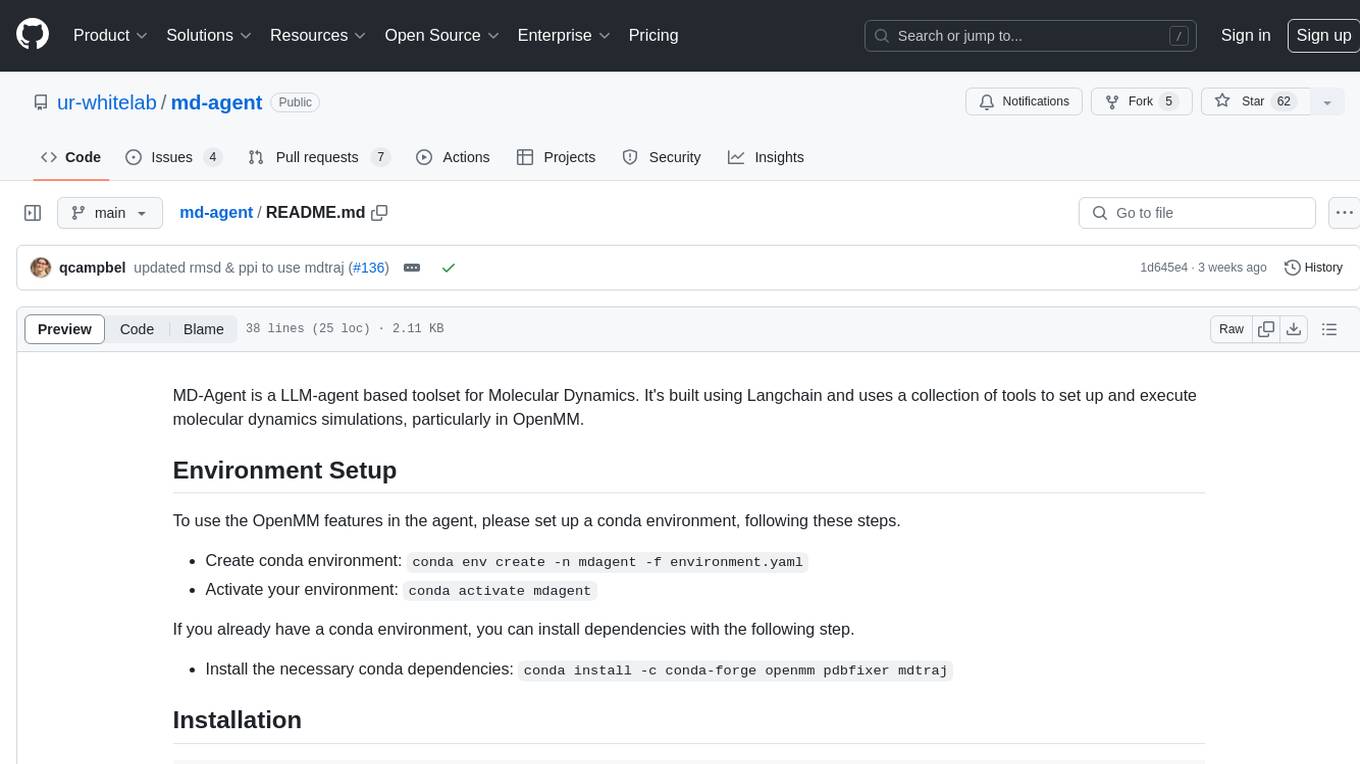
md-agent
MD-Agent is a LLM-agent based toolset for Molecular Dynamics. It uses Langchain and a collection of tools to set up and execute molecular dynamics simulations, particularly in OpenMM. The tool assists in environment setup, installation, and usage by providing detailed steps. It also requires API keys for certain functionalities, such as OpenAI and paper-qa for literature searches. Contributions to the project are welcome, with a detailed Contributor's Guide available for interested individuals.


